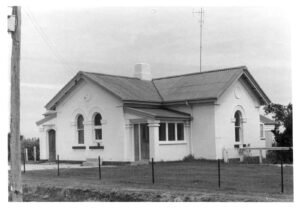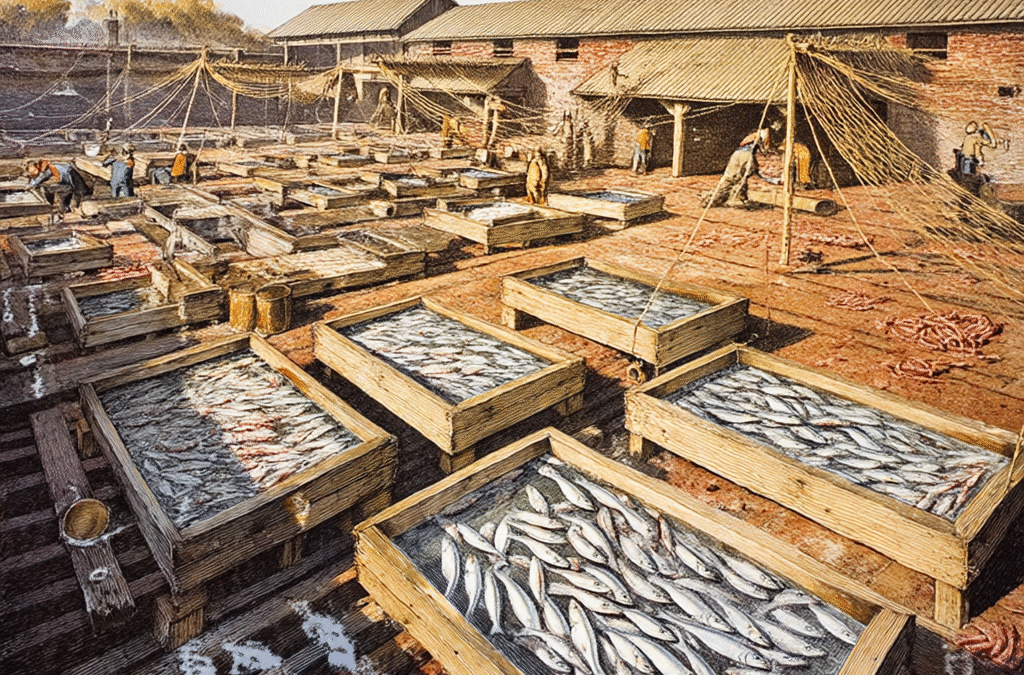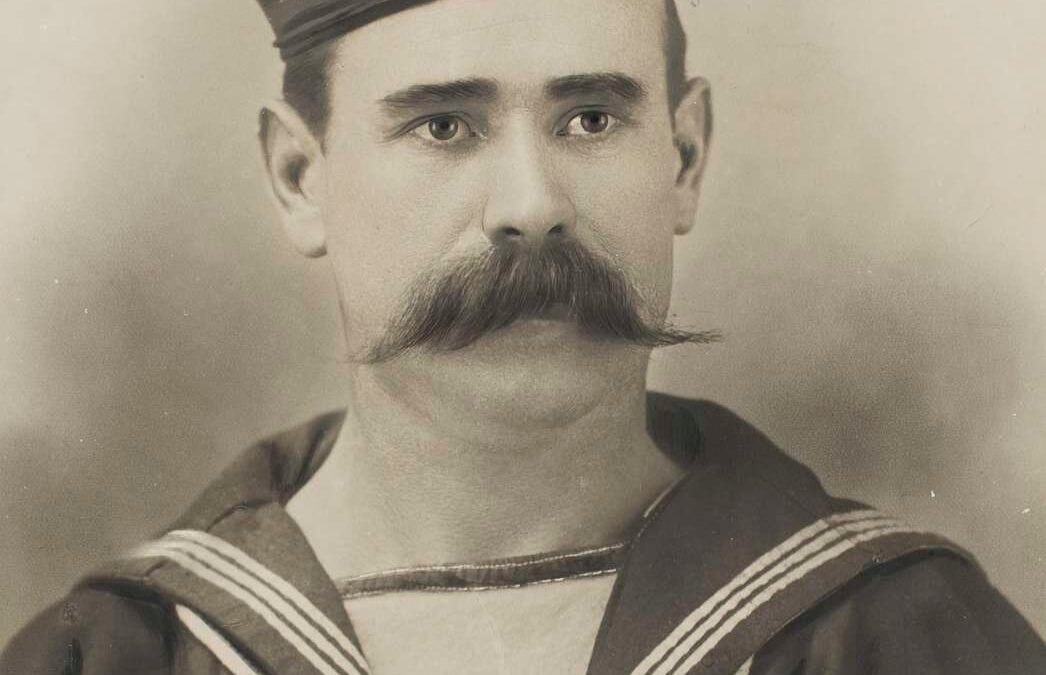The Shipwright’s Hands
The air is thick with the scent of salt and damp wood. A man kneels beside a half-built hull, running his fingers along the smooth, curved planks. He does not use nails—iron is scarce, and unnecessary. Instead, he stitches the wood together with cords of braided coconut fiber, binding each plank tightly with a technique his ancestors perfected generations ago. The ropes creak as he pulls them taut, sealing the seams with a mixture of resin and sap. In a few days, when the vessel is complete, it will set sail into the open ocean, its destination dictated by the winds and the stars.
This is not a shipwright from 16th-century Europe or even an artisan of the famed Phoenician fleets. He is an Austronesian craftsman, working in what is now Indonesia, over 3,000 years ago. His people, the first true deep-sea explorers, will travel thousands of miles, reaching Madagascar, the Pacific Islands, and possibly even Africa, long before European ships ever set sail. Their boats—fast, flexible, and built with an understanding of the sea that modern archaeologists are only beginning to grasp—will carry not just people, but entire cultures across the vast blue expanse.
For too long, history has celebrated the maritime achievements of the West—Phoenicians, Greeks, Vikings—while the seafarers of Asia have remained in the shadows. But recent discoveries suggest these forgotten shipwrights pioneered oceanic travel centuries before others dared venture beyond the coastline. Their innovations in shipbuilding, navigation, and trade shaped the ancient world in ways we are only now beginning to understand.
Who were these master shipwrights? How did they engineer vessels capable of crossing entire oceans with nothing but the wind and stars to guide them? And why has their legacy remained so obscured? To answer these questions, we must look beyond the familiar tales of Western exploration and dive into a maritime past that challenges everything we thought we knew.
The Lost Mariners: Asia’s Forgotten Seafaring Civilizations
Long before the Age of Exploration, before Greek triremes patrolled the Mediterranean or Viking longships raided the coasts of Europe, there were the Austronesians, the Harappans, and the early Chinese seafarers—mariners who built sophisticated vessels and mapped vast stretches of ocean with nothing but their knowledge of wind, waves, and stars.
The Austronesians: The First True Oceanic Explorers
 The Austronesians were not just sailors; they were the first people in history to colonize thousands of islands across a vast oceanic region, spanning from Taiwan to Madagascar, and from Hawaii to New Zealand. Around 3000 BCE, they began their expansion out of what is now southern China and Taiwan, carrying with them their language, agriculture, and advanced shipbuilding techniques.
The Austronesians were not just sailors; they were the first people in history to colonize thousands of islands across a vast oceanic region, spanning from Taiwan to Madagascar, and from Hawaii to New Zealand. Around 3000 BCE, they began their expansion out of what is now southern China and Taiwan, carrying with them their language, agriculture, and advanced shipbuilding techniques.
Their key innovation? The outrigger canoe, a lightweight yet stable vessel designed for open-sea travel. With this design, they crossed distances that would have terrified most ancient sailors—thousands of miles of open water, from Southeast Asia to the farthest reaches of the Pacific. The evidence of their journeys lies not just in the remains of ancient boats but in the cultural and linguistic fingerprints they left behind:
- Madagascar’s language (Malagasy) is Austronesian, not African, indicating that Austronesian sailors reached and settled the island around 500 CE—long before the Portuguese or Arabs ventured that far south.
- The sweet potato, a plant native to South America, was cultivated in Polynesia centuries before Europeans arrived, suggesting that Polynesians may have reached the Americas and returned with new crops.
Their ability to navigate across vast distances without compasses or maps was unparalleled. They read cloud formations, ocean currents, and even the flight paths of seabirds to locate distant islands. And yet, despite their extraordinary maritime achievements, the Austronesians are often overlooked in mainstream history.
The Harappans: India’s Forgotten Seafarers
 While the Austronesians were mastering the Pacific, the Harappan civilization (Indus Valley, c. 2500–1900 BCE) was conducting maritime trade with Mesopotamia, long before the rise of Greek or Roman navies. The city of Lothal, in modern-day India, had one of the world’s first known dockyards, an engineering feat that suggests they were building substantial seagoing vessels.
While the Austronesians were mastering the Pacific, the Harappan civilization (Indus Valley, c. 2500–1900 BCE) was conducting maritime trade with Mesopotamia, long before the rise of Greek or Roman navies. The city of Lothal, in modern-day India, had one of the world’s first known dockyards, an engineering feat that suggests they were building substantial seagoing vessels.
Archaeologists have found evidence of Harappan ships and maritime trade routes stretching from India to the Arabian Peninsula and possibly even East Africa. Their boats, likely made of wood planks stitched together with fiber cords, bear striking similarities to later Indian Ocean vessels, some of which are still built using the same techniques today.
Despite this, Harappan maritime history is often overshadowed by discussions of their impressive cities and sophisticated urban planning. But their mastery of shipbuilding and trade networks suggests they played a vital role in early global commerce.
Early Chinese Seafarers: Masters of the Monsoons
 China’s maritime history is usually associated with later dynasties—Zheng He’s massive treasure fleets of the 15th century, or the legendary junk ships of the Song Dynasty. But evidence suggests that Chinese mariners were sailing the South China Sea as early as 2000 BCE, trading with Southeast Asia and beyond.
China’s maritime history is usually associated with later dynasties—Zheng He’s massive treasure fleets of the 15th century, or the legendary junk ships of the Song Dynasty. But evidence suggests that Chinese mariners were sailing the South China Sea as early as 2000 BCE, trading with Southeast Asia and beyond.
Early Chinese ships were some of the first in the world to feature watertight bulkheads, an innovation that made them incredibly sturdy in rough seas. The use of the sternpost rudder, which they likely developed independently, revolutionized ship maneuverability and would later be adopted by Arab and European sailors.
There are even theories—though still debated—that ancient Chinese explorers may have reached the Americas long before Columbus. While the evidence is inconclusive, it highlights just how advanced China’s maritime capabilities were, even in ancient times.
Why Were These Seafarers Forgotten?
So why don’t we hear more about these ancient mariners? Part of the answer lies in historical narratives shaped by later European exploration, which often dismissed earlier non-Western achievements. Another factor is the ephemeral nature of wooden shipbuilding—unlike stone monuments or metal weapons, wooden boats decay quickly, leaving behind only faint archaeological traces.
But today, new discoveries and reconstructions of ancient vessels are rewriting the history of seafaring. These early Asian mariners were not merely traders or fishermen; they were pioneers who mapped and connected the ancient world long before the so-called “Age of Exploration” even began.
Engineering the Impossible: How Ancient Shipwrights Built Ocean-Going Vessels
The ocean is unforgiving. A poorly built vessel doesn’t just sink—it vanishes, swallowed by waves and time. For ancient shipwrights, survival depended on their ability to design boats that could withstand the fury of monsoons, the stillness of doldrums, and the vast emptiness of open water. And while early European ships often clung to coastlines, ancient Asian mariners built vessels capable of crossing entire oceans thousands of years ago.
But how did they do it? The secret wasn’t brute force—it was innovation, adaptation, and an understanding of the natural world that modern maritime engineers are only beginning to appreciate.
Sewn-Plank Boats: Holding the Ocean Together with Rope
Imagine a ship built without nails. No metal, no rivets—just wood, fiber, and an almost supernatural ability to bend nature to human will. That’s the sewn-plank boat, one of the oldest and most enduring shipbuilding techniques in history.
Used from the Indus Valley to Southeast Asia and the Indian Ocean, sewn-plank boats were constructed by stitching wooden planks together using coconut fiber ropes or plant fibers. The result? A flexible, resilient hull that could bend and absorb the shock of heavy waves, unlike the rigid, nailed-together ships of later European design.
 Reconstruction of what the Lothal dockyard may have looked like. Credit: IgorMorozoff/Wikimedia Commons
Reconstruction of what the Lothal dockyard may have looked like. Credit: IgorMorozoff/Wikimedia Commons
]Archaeological evidence of sewn-plank boats dates back at least 4,000 years:
- Lothal, India (c. 2400 BCE): Remains of a Harappan dockyard suggest the use of these boats for trading with Mesopotamia.
- Oman & the Arabian Peninsula: Archaeologists have reconstructed sewn-plank boats based on ancient designs, proving they were seaworthy and capable of long-distance travel.
- Indonesia & the Philippines: Some modern fishing boats still use versions of this ancient technique, a direct link to the past.
The durability of these vessels allowed early mariners to navigate the monsoon trade winds, connecting India, Southeast Asia, and the Middle East centuries before European empires even existed.
Outriggers & Catamarans: Stability for the Open Ocean
While sewn-plank boats gave early mariners flexibility, another key innovation gave them stability: the outrigger canoe. This design—essentially a canoe with a smaller lateral float attached—prevented capsizing in rough waters and allowed for long-distance voyaging.
This was the Austronesians’ secret weapon. With outriggers, double-hulled canoes, and eventually full catamarans, they created the fastest, most efficient ocean-going vessels of the ancient world. These boats weren’t just sturdy—they were fast, capable of covering hundreds of miles in a single journey.
The results were staggering:
- By 1500 BCE, Austronesians had spread from Taiwan to the Philippines, Indonesia, and the Pacific Islands.
- By 500 CE, they had reached Madagascar, bringing their language, plants, and animals—a journey of over 4,000 miles.
- Some Polynesian canoes could carry up to 80 people with supplies, making intentional long-distance voyages possible.
Today, traditional Polynesian voyaging societies continue to sail using these same designs, proving their effectiveness against modern vessels.
The Art of Wood Joinery: Building Without Nails
In China, India, and Southeast Asia, shipbuilders developed another approach to crafting large, sturdy vessels without relying on metal fastenings: wood joinery. Instead of stitching planks together, they used interlocking wooden dowels, mortise-and-tenon joints, and pegs.
The Chinese, in particular, became masters of this technique:
- Watertight bulkheads, a Chinese innovation dating back over 2,000 years, divided ships into compartments, reducing the risk of sinking if one section was breached.
- The sternpost rudder, another Chinese invention, allowed for greater maneuverability—something European ships wouldn’t adopt until centuries later.
Junk ships, which emerged during the Han Dynasty, used both of these features, making them some of the most advanced vessels of their time.
A Legacy That Still Sails
What’s remarkable is that many of these ancient shipbuilding techniques are still in use today. In parts of the Indian Ocean, fishermen still build sewn-plank boats using the same methods as their ancestors. In Polynesia, navigators continue to cross vast distances in outrigger canoes and double-hulled catamarans. And in China, modern shipbuilders still recognize the efficiency of bulkhead designs pioneered over 1,500 years ago.
Western history often frames the Age of Exploration as the dawn of oceanic travel. But the reality is, by the time European explorers set sail, Asian shipbuilders had already mastered the art of navigating the open sea—and they had been doing it for millennia.
Sailing Before the Compass: Navigational Mastery of Early Asian Mariners
A sailor stands at the edge of his vessel, watching the horizon shift as night falls. There is no map, no compass—only the sky and the sea. Yet he knows exactly where he is. The stars tell him latitude. The waves reveal hidden islands. The flight patterns of birds hint at land just beyond the horizon.
For thousands of years, before the invention of the magnetic compass, ancient Asian navigators developed systems so precise that modern experiments have shown they rival—even surpass—early Western navigational tools. While European explorers of the Middle Ages were still hugging coastlines, Austronesians, Indians, and Chinese mariners had already mapped vast oceanic highways, guided only by nature’s cues.
Reading the Stars, Feeling the Swells
The Austronesians, in particular, were masters of celestial navigation. Without written charts, they used a mental star compass—a knowledge system passed down through generations. Each star rose and set at a predictable point on the horizon, forming a natural guide.
- Polaris (the North Star) and the Southern Cross helped determine latitude.
- The Pleiades star cluster was used by Polynesians to time voyages, as its position in the sky marked seasonal wind shifts.
- Planets like Venus and Jupiter were used to track movement across long distances.
But they didn’t just rely on stars. They read the ocean itself:
- Wave refraction patterns revealed islands long before they were visible. Certain waves bounced off distant land masses, creating distinctive ripple effects in the water.
- Seabird flight paths indicated proximity to land—frigatebirds, for example, never stray too far from shore.
- Cloud formations over islands reflected sunlight in a way that skilled navigators could recognize from miles away.
Even today, Polynesian navigators continue to use these ancient techniques, proving their accuracy on trans-Pacific voyages without modern instruments.
The Monsoon Mariners of India and the Middle East
While Austronesians ruled the Pacific, Indian and Arab sailors mastered the Indian Ocean, developing monsoon-based navigation systems as early as 2500 BCE.
- Monsoon winds blow predictably in opposite directions each season, allowing traders to time their departures and arrivals perfectly.
- Sanskrit texts from the 1st century CE describe detailed wind and current patterns, long before similar knowledge appeared in European records.
- Harappan traders (Indus Valley Civilization) likely used this knowledge to sail to Mesopotamia and East Africa, forming some of the world’s earliest trade networks.
Arab and Indian navigators also pioneered the use of kamals, a simple but effective tool to measure latitude using the width of a finger against the horizon—an early precursor to the sextant.
China’s Early Navigation: Magnetic Marvels and Deep-Sea Exploration
China’s navigational advancements were unmatched for centuries. By 200 BCE, Chinese mariners were developing methods that would later revolutionize global exploration.
 The earliest magnetic compasses (4th century CE) were created in China, originally for geomancy but later adapted for navigation.
The earliest magnetic compasses (4th century CE) were created in China, originally for geomancy but later adapted for navigation.- Chinese ship logs from the Han Dynasty (c. 200 BCE) describe sophisticated deep-sea voyages using celestial navigation and early compass prototypes.
- By the Tang Dynasty (618–907 CE), Chinese merchants were using star charts and rudimentary maps to navigate between China, India, and the Middle East.
Their junk ships, with their watertight bulkheads and sternpost rudders, were far more advanced than contemporary European vessels. By the time Zheng He launched his famous treasure fleet in the 15th century, Chinese sailors had already been mastering the seas for over a thousand years.
The Silent Genius of Pre-Modern Navigation
Perhaps the most astonishing part of early Asian navigation is that so much of it was never written down. Polynesians, Indian Ocean traders, and early Chinese mariners relied on oral traditions, memory, and observation rather than written records.
This knowledge was passed from master to apprentice, from one generation to the next. And despite the rise of modern navigation technology, traditional techniques still work—Polynesian voyaging societies continue to sail thousands of miles without compasses, just as their ancestors did.
The Western world often credits itself with “discovering” global navigation, but in reality, ancient Asian mariners had already mapped and mastered the seas, using nothing but their deep understanding of the natural world.
The Global Impact: How These Early Seafarers Shaped Trade, Culture, and Exploration
A bundle of cinnamon bark sits on the deck of a ship, bound for a distant land. The crew speaks a mix of languages—Malay, Tamil, Arabic—blending words like the spices in their cargo. The sea is not a barrier to these people; it is a bridge. And long before the famed Silk Road, it was the ocean, not the land, that carried the first wave of globalization.
Before the Silk Road, There Was the Spice Route
Trade did not begin with Marco Polo or the European Age of Exploration. Thousands of years earlier, Asian seafarers had already created vast maritime networks stretching from China to Africa. These routes allowed for the movement of not just goods, but ideas, religions, and even genetic lineages.
- Indian and Southeast Asian traders were shipping spices, textiles, and precious stones to the Middle East and beyond as early as 2000 BCE. The port cities of the Indus Valley civilization had connections with Mesopotamia, evidenced by Indus seals found in ancient Sumer.
- The Austronesians helped establish one of the first transoceanic trade networks, sailing between Southeast Asia, Madagascar, and East Africa. This explains why banana and taro plants, native to Southeast Asia, appear in Africa by 500 CE—brought over by Austronesian traders.
- By the 1st century CE, Chinese ships were regularly traveling as far as the Persian Gulf and East Africa, carrying silk, ceramics, and other luxury goods.
These early maritime highways were not just about trade; they were pathways of cultural exchange.
Religions and Languages That Crossed the Waves
Many of the world’s major religions and cultural influences spread not by war or conquest, but by sailors and merchants.
- Hinduism and Buddhism traveled from India to Southeast Asia via maritime trade routes. Ancient temples in Cambodia, Indonesia, and Vietnam show strong Indian influences, the result of centuries of sea-based cultural exchange.
- Islam spread along the maritime routes of the Indian Ocean. Muslim traders from the Arabian Peninsula established communities in Indonesia and Malaysia as early as the 7th century.
- The Malagasy language spoken in Madagascar today is closely related to Austronesian languages from Borneo, proving that seafarers from Southeast Asia settled the island long before Arab or European explorers.
Did They Reach the Americas Before Columbus?
One of the more controversial questions in maritime history is whether Asian seafarers reached the Americas before Columbus.
- Sweet potatoes, a crop native to South America, were being grown in Polynesia centuries before European contact. DNA evidence suggests that Polynesians may have reached South America and brought the crop back with them.
- Some researchers have proposed that early Chinese or Austronesian sailors could have made it to the west coast of the Americas, though the evidence remains debated.
While we may never know for certain, it is clear that Asian maritime cultures were capable of such voyages—long before Europeans even considered crossing the Atlantic.
How These Ancient Traditions Influenced Later Maritime Empires
The legacy of these early shipbuilders and sailors did not disappear—it was absorbed into later maritime powers.
- Chinese shipbuilding techniques influenced Arab dhow construction, which in turn shaped early European ships.
- The Portuguese and Spanish, pioneers of the so-called “Age of Exploration,” relied on Indian Ocean trade networks that had existed for centuries before they arrived.
- Even modern container ships owe much to the ancient bulkhead designs pioneered by Chinese shipbuilders over a thousand years ago.
The modern world often credits Europe with discovering and connecting distant lands, but it was the forgotten seafarers of Asia who first mapped and mastered the global ocean highways.
The Rediscovery: Reconstructing and Sailing These Ancient Vessels Today
For centuries, the legacy of Asia’s first master shipwrights was buried under the waves—forgotten by history, overshadowed by the narratives of later European explorers. But in recent decades, archaeologists, sailors, and historians have begun to rebuild and sail these ancient vessels, proving that the achievements of early Asian mariners were more than just theory. These weren’t primitive boats clinging to coastlines—they were sophisticated ocean-going ships, capable of crossing vast distances with remarkable efficiency.
Experimental Voyaging: Sailing Like the Ancients
Modern attempts to reconstruct and sail ancient Asian ships have produced stunning results. Some of the most ambitious projects include:
 The Hōkūleʻa (1976–present) – A Polynesian double-hulled canoe built to test traditional Austronesian navigation. Sailing without compasses or maps, the crew successfully navigated from Hawaii to Tahiti, covering 2,500 miles just as their ancestors did. This voyage proved that ancient Austronesians could have intentionally settled the Pacific using sophisticated maritime knowledge.
The Hōkūleʻa (1976–present) – A Polynesian double-hulled canoe built to test traditional Austronesian navigation. Sailing without compasses or maps, the crew successfully navigated from Hawaii to Tahiti, covering 2,500 miles just as their ancestors did. This voyage proved that ancient Austronesians could have intentionally settled the Pacific using sophisticated maritime knowledge.- The Borobudur Ship Expedition (2003–2004) – An Indonesian vessel, modeled after 8th-century bas-reliefs from the Borobudur temple, was built using traditional methods. It successfully sailed from Indonesia to Ghana, proving that early Southeast Asian sailors could have traveled as far as Africa.
- The Jewel of Muscat (2010) – A reconstruction of a 9th-century Arab dhow, built using ancient sewn-plank techniques, was sailed from Oman to Singapore. The voyage demonstrated how early Indian Ocean traders moved goods between the Middle East and Asia.
Each of these projects has forced historians to reconsider the technological capabilities of ancient shipbuilders. What was once dismissed as impossible has been physically proven through these reconstructions.
Archaeological Discoveries: The Ghosts of Forgotten Ships
While wooden ships rarely survive thousands of years, archaeologists have uncovered tantalizing evidence of early Asian shipbuilding traditions:
- The Belitung Shipwreck (c. 9th century CE) – A Chinese-made vessel found off the coast of Indonesia, containing Tang Dynasty ceramics bound for the Middle East. The ship’s design suggested it was built in China but sailed by an international crew, highlighting the global reach of early maritime trade.
 The Nanhai No. 1 (c. 12th century CE) – A Song Dynasty trading vessel discovered off the coast of China, loaded with porcelain and gold. Its well-preserved bulkhead design confirmed that ancient Chinese shipbuilders were centuries ahead of their European counterparts.
The Nanhai No. 1 (c. 12th century CE) – A Song Dynasty trading vessel discovered off the coast of China, loaded with porcelain and gold. Its well-preserved bulkhead design confirmed that ancient Chinese shipbuilders were centuries ahead of their European counterparts.- Remains of Austronesian outrigger canoes found in the Philippines, Madagascar, and even South America suggest that these vessels enabled some of the earliest long-distance migrations in human history.
These finds, along with modern reconstructions, have rewritten maritime history. The shipbuilding techniques of these early seafarers were not crude improvisations—they were highly refined, evolved over centuries, and capable of shaping entire civilizations.
Why This Matters: A Legacy Worth Remembering
For too long, the story of the sea has been told through the lens of European exploration. The voyages of Columbus, Magellan, and Vasco da Gama dominate history books, while the forgotten seafarers of Asia remain largely unknown. But the reality is, by the time European explorers set sail, the ocean had already been mapped by the Austronesians, Indians, Chinese, and Arab mariners who came before them.
Today, indigenous maritime communities across Asia and the Pacific are working to revive these traditions—not just as historical exercises, but as living, breathing practices that connect them to their ancestors. Traditional navigation schools, wooden shipbuilding revivals, and deep-sea voyaging projects are ensuring that this ancient knowledge is not lost to time.
The master shipwrights of Asia built more than boats—they built the first bridges between civilizations. And though their names may have faded, their legacy still sails on the waves.
The First Shipwrights and Their Lasting Legacy
The scent of salt and wood resin lingers in the air as the last fibers are pulled tight. A master shipwright steps back, hands calloused from years of labor, and surveys his creation—a vessel that will soon disappear into the horizon, carrying people, stories, and cultures to places unseen. He does not know that thousands of years later, his craftsmanship will be rediscovered, that the techniques he passed down through generations will be proven once again on the open sea.
The story of maritime exploration has long been framed as a European triumph. But the reality is that long before the Age of Exploration, Asian shipbuilders and sailors had already mastered the art of ocean travel. They crossed vast distances without compasses, charted global trade routes without maps, and built ships whose designs would influence generations of sailors.
Their legacy is not just historical—it is alive. In Polynesia, navigators still read the waves as their ancestors did. In India and Oman, craftsmen still build sewn-plank boats using techniques that date back millennia. In China, the bulkhead designs first developed in ancient shipyards still form the basis of modern cargo ships.
These forgotten seafarers were not just sailors or traders—they were pioneers, engineers, and visionaries. Their ships did more than transport goods; they connected worlds. And now, as archaeologists, historians, and modern voyagers continue to reconstruct and sail these ancient vessels, the full extent of their achievements is finally being recognized.
The ocean remembers. And as we uncover more of its secrets, it is clear that the first great age of exploration did not begin with Columbus or Magellan. It began thousands of years earlier, with the first master shipwrights of Asia—builders of the world’s first global highways, architects of a legacy that still moves with the tide.
 Today it remains a private residence, carefully restored and adapted for modern use. More recent owners have retained its defining features – high ceilings, arched windows, Baltic pine floors, and solid brickwork – while adding an accommodation wing at the rear. The building sits within a 1,597 square-metre block overlooking the historic Government Wharf, its courtyard shaded by mature trees.
Today it remains a private residence, carefully restored and adapted for modern use. More recent owners have retained its defining features – high ceilings, arched windows, Baltic pine floors, and solid brickwork – while adding an accommodation wing at the rear. The building sits within a 1,597 square-metre block overlooking the historic Government Wharf, its courtyard shaded by mature trees. The Port Albert post office was built in a conservative Italianate style, a restrained interpretation of the architecture popular in Melbourne during the 1860s. Its symmetrical façade, bracketed eaves, and tall arched windows gave the small coastal town a touch of metropolitan civility.
The Port Albert post office was built in a conservative Italianate style, a restrained interpretation of the architecture popular in Melbourne during the 1860s. Its symmetrical façade, bracketed eaves, and tall arched windows gave the small coastal town a touch of metropolitan civility. Port Albert’s prosperity peaked in the 1860s. As railways reached inland towns, trade routes shifted, and larger ships bypassed the shallow inlet. The port declined, but the post office endured.
Port Albert’s prosperity peaked in the 1860s. As railways reached inland towns, trade routes shifted, and larger ships bypassed the shallow inlet. The port declined, but the post office endured. An Enduring Connection
An Enduring Connection


